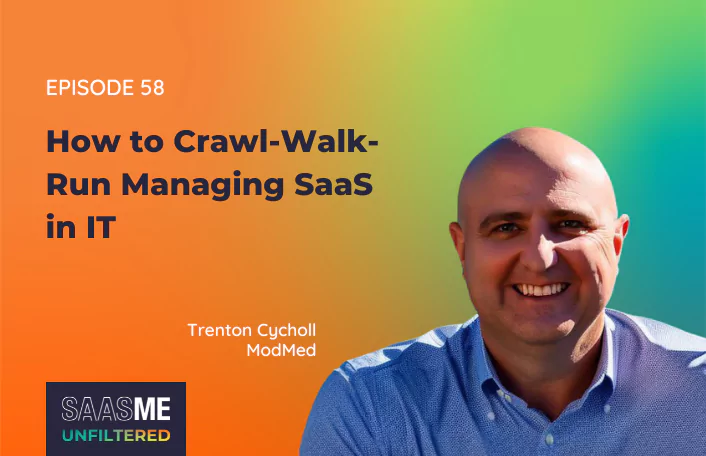04/25/2024
Table of Contents
To achieve operational excellence, save money, and drive innovation, IT leaders must have effective processes in place. But, what’s the best approach? Look no further than Trenton Cycholl. As VP of Digital Business at ModMed, Trenton has a software management process on lock to not only reduce administrative burden for IT, but to also drive usage and adoption. In this episode, get an inside look at this process and how to crawl-walk-run your way to a successful SaaS Management program.
Listen to the full episode on Spotify or Apple Podcasts.
Episode Summary
With 650 SaaS applications in the average enterprise, it may feel like an impossible task to manage them all.
According to Trenton Cycholl, VP, Digital Business at Modernizing Medicine, IT needs to take a crawl-walk-run approach.
To start, Cycholl explained, “It’s a lot of inventory exercise and a lot of data collection.” Before you can manage anything, you must know what you have.
“I’ve done it the hard way,” shared Cycholl. “I’ve kept things in a spreadsheet and I play whack-a-mole with technology, trying to find and keep updated with everything. But the fact is there’s automation that’s necessary.”
Read on for key lessons Cycholl shares about his SaaS Management journey and how to effectively crawl-walk-run your way to success.
Guest Spotlight
Name: Trenton Cycholl
What he does: VP, Digital Business at Modernizing Medicine (aka ModMed)
Connect with Trenton online: Linkedin
Episode Highlights
Using a Tiering Framework Helps IT Prioritize the Right Support for Applications
“We spend a lot of time tiering our applications, where we can engage and partner with the business at the right level, at the right time and at the right frequency. Quite honestly because there are a lot of tools that our business teams and operational teams are self-enabled on, but there still needs to be governance for things like user ID passwords.
Tier One type applications, we do end-to-end management, full service, full scale. This is the more traditional model of, I’ve got an enterprise system I want to implement. Tier Two, we’re an administrative arm. We help with a lot of the tasks that are more traditional IT functions, and these are typically systems that will integrate with our core. And then Tier Three we’re just consultants on this. We provide inputs, we provide guidance. They’re typically not systems that will integrate with our core, but they might solve a particular departmental need or objective.
Being able to segment allows us to get involved at the right level, because IT is never staffed at the level to be 100% involved with all technology. We have to pick and choose the ones that are going to be the biggest movers for the company and invest the IT resources in those first.”
Legacy Processes for Managing Software No Longer Work
“If you look at legacy technology, the previous ways, the selection, procurement, analysis was done on a tool or technologies was one of, ‘let’s spend six months on a project to select an enterprise tool to run our ERP.’ And everybody got involved, everybody took the time, everybody took the effort. I think everyone’s defaulted into reusing that same methodology to try to get involved with every piece of tech. In today’s SaaS world, it is not one that’s going to move at an agile speed that’s going to keep an enterprise moving fast. We learned from just experience of seeing it not work a few times and trying to be IT and getting in the way and using legacy processes. Those days are gone, and we have to make sure we’re getting involved with the right things and the ones that are going to be the highest risk or the ones that are going to be again, the highest value to the company.”
Crawl: Getting an Inventory of What You Have
“The first step is, ‘let’s figure out what technologies exist? Where do we have them? Who is owning them? Who’s passionate about some of them?’ It’s a lot of inventory exercise and a lot of data collection. Understanding that first is the first step and that helps with everything that we’re doing here with app tiering, with any of the discussions around how we do SaaS management. This is all a concrete foundational step you’ve got to take to be able to take steps beyond.”
Walk: Day-to-Day Management of Your SaaS Apps
“It’s optimizing, so rationalizing and optimizing what we have. It’s also making sure we have all the right ownership. Being real clear on ownership is also a big part of this, that understanding who owns what, and that can be the technology owner, that can be the business owner who owns how this functionality works within the business and the administration or traditional sort of IT stuff. But the real work comes in, ‘okay, how do we align all of that?’ And when we are managing a tool effectively, we’re understanding everything about it, the cost, the renewal, the timing of when things need to be considered for decision making. Because a lot of times some of this cost savings is all based on contract dates. That’s the only time you can really identify. Managing it is understanding every detail about the technology, the partnership. Do we have a good vendor relationship here? Do we have good contacts? Do we know who we’re supposed to talk to? Who is the person who implemented that is still at the company?”
Run: Operationalizing Your SaaS Management Program
“I’ve done it the hard way. I’ve kept things in a spreadsheet and I update them and I play whack-a-mole with technology, trying to find and keep updated with everything. But the fact is there’s automation that’s necessary, which is in that data collection step. So once you have the initial inventory, an ongoing inventory has to continue. We’ve leveraged the Zylo platform to automate a lot of the management and the ongoing maintenance of our program here. So everything from, do we have enough licenses? Do we have too many licenses? Do we need to be ready for that renewal? Are we seeing new tools being bought that are redundant? Do we need to optimize some of the current tech stack that’s there? I spent hours and hours keeping up with spreadsheets only to find out, when I’d go to present to our executive team in a former life, that my data was out of date. It was both embarrassing as well as not a real good career step and getting in front of executives with the wrong information.”
Top Quotes
10:38 – “We have to pick and choose the ones that are going to be the biggest movers for the company and invest the IT resources in those first.”
16:22 – “It’s a lot of inventory exercise and a lot of data collection. Understanding that first is the first step.”
20:36 – “I’ve done it the hard way. I’ve kept things in a spreadsheet and I update them and I play whack-a-mole with technology, trying to find and keep updated with everything. But the fact is there’s automation that’s necessary.”
Listen and subscribe to SaaSMe Unfiltered wherever you listen to podcasts.
ABOUT THE AUTHOR

Cory Wheeler
As Zylo’s Chief Customer Officer, Cory is responsible for helping our customers drive ROI and SaaS Management success with Zylo. He helps companies of all sizes effectively discover, optimize, and govern their SaaS through Zylo’s platform and services. Prior to founding Zylo, Cory spent 15 years in finance and procurement, managing categories and sourcing teams at Arthur Andersen, BearingPoint, and both Takeda and Astellas Pharmaceuticals. He built the procurement organization at ExactTarget, and managed the integration with the Salesforce Marketing Cloud procurement organization in 2015. He and his family reside in Indianapolis, IN, where they can be found cheering for the Purdue Boilermakers and Chicago Cubs.

